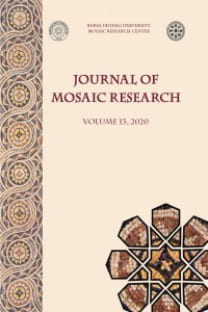Roma İmparatorluğu’nun Batısı ve Doğusu’ndan Geometrik Desenli Mozaikler: Kum Saati Motifi ve “Le Décor Géométrique de la Mosaïque Romaine I-II ” kitabının önemi
İki mozaik döşemeye sahip bir ev keşfedildi ve özellikleri nedeniyle, Bracara Augusta’da (Portekiz) müze binasının bodrumunda tutulmaya karar verildi. Mozaik zeminlerden biri, zıt renkli dama tahtası deseninden oluşurken, diğeri kum saati motifinden meydana gelmiştir. Bu makalede farklı kompozisyonlara uygulanan kum saati motifi, Roma mozaik uluslararası tanımlama standardizasyonu yardımıyla ve Roma dünyasının batısından (Portekiz) doğusuna (Türkiye) aynı desen ile karşılaştırılarak sunulacaktır
Anahtar Kelimeler:
Bracara Augusta, Roma mozaikleri, korpus, geometrik desenler, kum saati
The Mosaics with Geometric Patterns from the West and the East of the Roman Empire: The Hourglass Pattern and the Significance of the “Le Décor Géométrique de la Mosaïque Romaine I-II ”
The structures of a domus with two mosaics were discovered, and due to its features, it was decided to keep it integrated in the crypt of the Museum building in Bracara Augusta (Portugal). One of the mosaic floors consists on a chessboard pattern, with contrasting colours and the other is furnished with hourglass gridlines. A study of the hourglass motif integrated into different compositions will be presented here, helping to the international standardization of the description of the Roman Mosaic and trying to confront the same pattern from the West (Portugal) to the East (Turkey) of the Roman World
Keywords:
Bracara Augusta, roman mosaics, corpus, geometric patterns, hourglass,
- ISSN: 1309-047X
- Başlangıç: 2008
- Yayıncı: Ululdağ Üniversitesi, Mozaik Araştırlmaları Merkezi
Sayıdaki Diğer Makaleler
Doğu Batı ile Buluşuyor: Roma Mozaiklerindeki Perspektif
Arnavutluk’taki Düzensiz Tesseralı Mozaikler (İ.Ö. 3. yy. - 1. yy.)
Perinthos-Herakleia Bazilikası Taban Döşemelerinin Konservasyonu
Simonetta Angiolillo, Chiara Pilo
